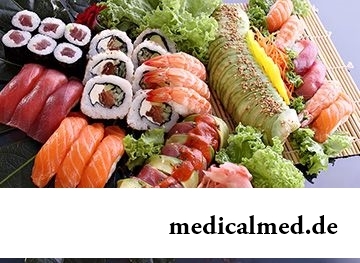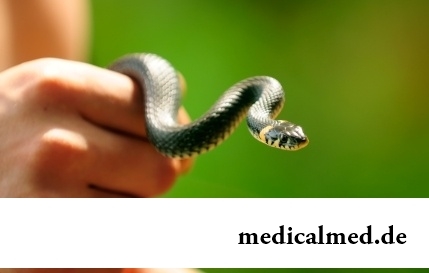





Caloric content of sushi
Sushi or sushi – the traditional Japanese dish consisting of a large amount of ingredients therefore the caloric content of sushi depends on the products used for their preparation.
Traditional Japanese sushi:
- Nigirudzus (to Niger – in Japanese a handful) – the most widespread way of preparation used in European cuisine;
- Makidzus – Kolobok from rice with a stuffing inside wrapped in leaves of seaweed of a chain pump;
- Osidzus – the rice laid in a small wooden box from above gives all the best fish;
- Tirasidzus – the rice which is laid out on a dish powdered from above with vegetables or seafood.
Basis of preparation of any kind of sushi is in a special way the boiled rice of special grades. At rice which is used for sushi, caloric content from 330 to 340 kcal in 100 g.
Sushi diet
Considering that sushi – food portion, quantity the caloric content of sushi in a diet is calculated not on 100 g, and on 1 piece. Depending on the products used for making sushi, caloric content fluctuates from 60 to 100 kcal in 1 piece.
The diet is recommended to sushi not only because of the low caloric content of sushi and beaters, but also as the diet rich with valuable nutrients, vitamins and minerals at the minimum content of the fats presented generally polyunsaturated fat the Omega-3 by acids.
One more advantage of sushi of a diet – its sytnost. At the low caloric content of sushi, thanks to a large amount of complex carbohydrates and the celluloses which are contained in rice, a stomach it is well filled, and food long is digested and is slowly acquired. Increase duration of digestion of food of a squirrel and fats which in a small amount are present at the products supplementing rice in sushi (sea fish, caviar, seafood, a special omelet, Philadelphia cheese or tofu). It allows not to feel long enough feeling of hunger, maintaining breaks between meals, despite the low caloric content of sushi.
It is easy for sushi to diversify a diet, considering a large number of various options of making sushi with various filling. It is possible to eat to five different types sushi in any meal as at the admissible daily caloric content of 1500 kcal, in day they can be eaten from 15 to 25 pieces. Except sushi it is allowed to diversify a diet with salads, miso-soups and sashimi.
The diet at tendency to allergic diseases, gastritis and stomach ulcer is contraindicated to sushi.
Kinds of beaters and sushi, caloric content
In the menu of the Europeanized sushi – bars and restaurants, such views of the land most often meet:
- Beaters (sushi poppies, norimak, makidzus) – the thin, thick or turned-out sushi wrapped in a chain pump alga;
- Nigiri (nigiri-dzus) – modelled sushi;
- Uramaki (syakamaka) – round, the average size beaters "inside out", with several types of a stuffing;
- Temaki-sushi – the sushi wrapped in the chain pump seaweed curtailed in the form of kulechok;
- Inari – the sacks made of a special omelet or tofu cheese, stuffed with rice and other ingredients of sushi;
- Sashimi – the seafood cut by thin layers or a loin of crude fish;
- Gongkan (gunkandzus) – the small oval sushi in a form reminding boats or ships with a stuffing from above of rice;
- Tirasi-dzus (gomoku-dzus, bar-dzusi) – the loose sushi reminding rice salad.
We will consider the caloric content of sushi and beaters depending on a look and filling below:
- Beaters (California type) with a cucumber or avocado, a shrimp or crabmeat and caviar of flying fish – 100 kcal;
- Beaters with vegetables or with avocado – 50 kcal;
- Beaters with a cucumber and crabmeat, avocado or a lettuce leaf – 75 kcal;
- Beaters (Philadelphia type) with a cucumber at various fat content of cheese – from 100 to 125 kcal;
- The beaters (Philadelphia or Moscow type) wrapped in thin layers of fillet of a salmon with a smoked eel stuffing – 195 kcal;
- Beaters with cucumbers and the Japanese omelet – 125-140 kcal;
- The beaters (Dragon type) wrapped by a smoked eel with an avocado or cucumber stuffing with Philadelphia cheese - 260 kcal;
- Sushi with a smoked eel, a salmon, a shrimp, a scallop, a tuna, an octopus, a squid, a yellowtail (rudderfish) or the Japanese omelet – 10-50 kcal;
- Nigiri with a crab, an octopus, caviar of a salmon or flying fish – 45-55 kcal;
- Sashimi from squids – 75-87 какл;
- Sashimi from a yellowtail (rudderfish), an octopus or a grouper – 95-105 kcal;
- Sashimi from flitch or a tuna – 100-110 kcal;
- Sashimi from fillet of a salmon – 170 kcal;
- Sashimi from an eel smoked – 330 kcal.
The calories which are contained in sushi supply an organism with necessary energy. Besides, components of sushi are a source of iron, calcium, iodine, B12 vitamin, complex carbohydrates, celluloses, Omega-3 and Omega-6 polyunsaturated fatty acids, high-quality proteins.
How many calories in sushi ingredients
The sushi which are especially Europeanized is a convenient and useful food designer in whom, using as a basis the main ingredients and considering personal flavoring preferences and existence of available product set, it is possible to invent for himself fine food. What contents in sushi of calories, it is important to know on condition of observance of a diet.
To count калораж simply, knowing how many calories in sushi ingredients (average value of kcal in 100 g of a product):
- Rice – 335;
- Smoked eel – 326;
- Salmon – 195;
- Shrimps – 100;
- Crab meat – 87;
- Mussels – 77;

- Caviar red – 250;
- Tobiko (caviar of flying fish) – 280;
- Philadelphia cheese – 253;
- Tofu cheese – 76;
- Spaysi-sous – 588;
- Unagi-sous – 236;
- Teriyaki sauce – 119;
- Soy sauce – 70;
- Wasabi – 60;
- Ginger – 17;
- Rice vinegar – 12.
Irrespective of caloric content, sushi is a fine food, on condition of use for their preparation of the freshest fish, algas, the best grades of rice and other qualitative ingredients.
The 74-year-old resident of Australia James Harrison became blood donor about 1000 times. It has a rare blood group which antibodies help to survive the newborn with a severe form of anemia. Thus, the Australian saved about two million children.

We present to yours the TOP of the medicamentous means exerting the stimulating impact on a potentiality, i.e. on ability of a muzhcha...
Section: Articles about health
Heart disease and blood vessels lead to disturbance of blood supply of bodies and fabrics that involves failures in their work, deterioration in health of the person, decrease in its working capacity and standard of living. Annually such perishes from pathologies more...
Section: Articles about health
Ability of an organism to resist to adverse environmental factors (to impact of temperature drops, humidity and pressure, to the attacks of causative organisms, etc.) directly depends on what the person eats. Business here not only in that cells of a body received a necessary set of nutrients, vitamins and microelements. Scientists established that such components which are capable to influence negatively immune system, in connection with also are a part of foodstuff...
Section: Articles about health
Diseases of joints often begin imperceptibly for the person. The first stages of destruction of the cartilaginous tissue providing soft and свободн...
Section: Articles about health
Condition of lips (their morbidity, outward) – one of indicators of health of the person. The peeling, dryness, pallor, and also cracks in corners of a mouth can be not only the cosmetic shortcoming which arose owing to physical damages and weather having sent away...
Section: Articles about health
What woman does not dream of a beautiful and thick hair? While physicians developed difficult schemes on hair transplant, in the industry of hairdresser's art a few years ago there was a sensation – methods of hair extension appeared. It would seem, dreams came true: though the procedure of building also does not belong to the category cheap, practically any woman can increase several times the volume of hair, change their length and color – generally, to become the real beauty queen....
Section: Articles about health
All of us, unfortunately, should face flu nearly an every year. It would seem, so frequent disease has to be study...
Section: Articles about health
Statistically, can only one of ten of our compatriots brag of a decent condition of an oral cavity. Six teeth affected with caries are the share of the average Russian. For comparison, this indicator for Europeans almost six times exchanges...
Section: Articles about health
Transfusion of donor blood has almost century history. In spite of the fact that this procedure is quite usual for many people, process of blood donation is still surrounded with numerous myths. Today we aimed to discredit the most widespread of them....
Section: Articles about health
The immunity role in growth of the child is invaluable. The proteins-immunoglobulins produced by immune system preserve the child against diseases...
Section: Articles about health
The unpleasant feelings connected with spring breakdown are familiar almost to each of us. Often happens that in March-April on the person weakness leans: he suffers from drowsiness, complains of bad mood, loss of interest in life and failures in affairs....
Section: Articles about health
Health and attractiveness - eternal values, pursuing which people often use the most unusual ingredients and technicians. Let's consider 11 most exotic and sometimes not most pleasant Spa procedures to which the person in a pursuit of beauty and youth agrees....
Section: Articles about health
It is known that the person for 80% consists of water which participates in all processes of an organism. The person loses liquid daily – in...
Section: Articles about health
It would seem, to buy drugs in Moscow does not make a problem – a drugstore, and not one, is available for each resident of the capital within walking distance. And, nevertheless, Internet drugstores become more popular – what it is possible to explain such phenomenon with? Actually m reasons...
Section: Articles about health
The stroke is one of the most widespread diseases of the person, annually in the world about 6 million cases of this pathology are registered. According to medical statistics, strokes occur almost three times more often than myocardial infarctions. The disease belongs to heavy, and has an unfavourable result: the lethality reaches 40% among women and 25% among men. A considerable part of the patients who endured a stroke cannot be recovered completely. We suggest readers to examine...
Section: Articles about health
New year, wedding, birthday, office party – an occasion to drink at the Russian person will always be. How to reduce a negative impact...
Section: Articles about health
You heard that laughter prolongs life? Researchers did not manage to establish longevity direct link with sincere fun yet, but several facts confirming beneficial influence of risibility on the state of health are clinically proved....
Section: Articles about health
Feeding by a breast - the integral part of ideal motherhood allowing to come into contact with the kid and to create to it healthy immunity since early years. Nevertheless, this important process in life of mother and child can be saddened laktostazy − by a milk delay in a mammary gland. What main reasons for a laktostaz? How not to allow problems with breastfeeding? Let's consider 10 premises resulting in stagnation of milk at the nursing mother....
Section: Articles about health
It is pleasant to state a possibility of improvement of quality of life of people with problems of functioning of secretory system. By efforts that...
Section: Articles about health
Life activity of one-celled fungi of the sort Candida, related to yeast is a proximate cause of development of candidiasis (milkwoman). Normal these microorganisms are a part of the microflora living in an oral cavity and intestines of most of people, and that...
Section: Articles about health
The cosmetics intended for improvement of a condition of skin, nails and hair are used by each woman. Expenses on regular acquisition of the fashionable widely advertized products of well-known companies for many become very notable and significantly burden the family budget. Meanwhile, there is a number of inexpensive pharmaceutical drugs which can quite be applied in the cosmetic purposes. At the same time the effect of their use is often more noticeable, than result of use of the most expensive...
Section: Articles about health
Climax - process of fading of reproductive function of an organism in process of its aging. At women the main sign of its approach showing...
Section: Articles about health
The words "disease" and "patient" not without reason come from one root – "pain". As a rule, symptoms of illnesses thoroughly spoil to patients life. However from this rule there are exceptions. Some diseases are shown by signs which can cause even полож...
Section: Articles about health
Any person who faced a disease knows that treatment costs expensive. It belongs also to consultations of qualified specialists, and to the diagnostic procedures which are not included in the list of obligatory medical services. The question of cost of medicines is not so unambiguous: almost each drug is produced several producers at once, and the price of medicine can differ many times. In such situation there is a sense to understand in what differ from each other original environments...
Section: Articles about health
Cystitis, or inflammation of a mucous membrane of a bladder, this very widespread disease, which, owing to some persons...
Section: Articles about health
The state of health of the person depends on many factors. One of the most important is the constant, but not exhausting a physical activity. In the presence of various illnesses specialists often advise patients to do swimming which by right borrows ведущ...
Section: Articles about health
Popular joke that there are no healthy people, and is nedoobsledovanny, most of us considers an honest truth, continually it is necessary to hear that all of us are sick hardly from a school bench. It is hard to say whether so it actually because too often people are treated for nonexistent diseases, and sometimes call a disease what is something another. Sometimes in it the doctors of old school making diagnoses which are cancelled long ago – medicine still unless are guilty...
Section: Articles about health
